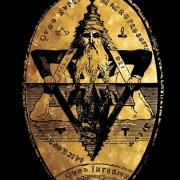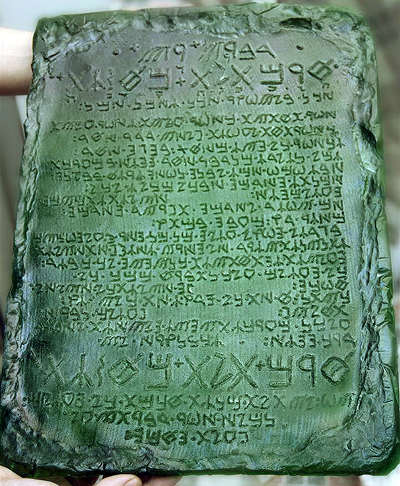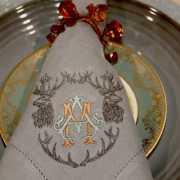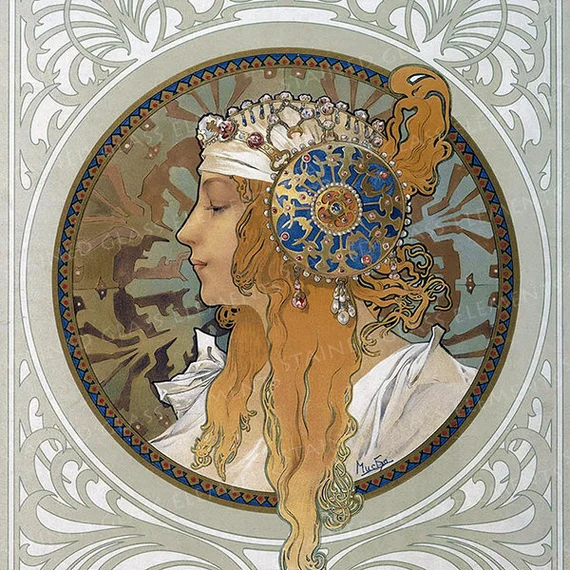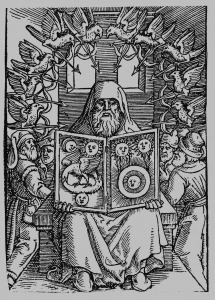
He was seen as an ancient prophet who revealed secret knowledge to man, and is the central figure in Hermetism. In antiquity, all kinds of hermetics were attributed to him; practical texts on alchemy, magic and astrology, but also mystical texts that were meant to lead to the acquisition of gnosis, such as the Corpus Hermeticum and the Asclepius.
The Emerald Table is a short, cryptic text that inspired the alchemists. According to popular legend, it was written by this mythical Hermes Trismegistus, but there are other stories about its origin. Whether the Emerald Tablet is a product of antiquity or was written in the early Middle Ages is still undecided. The most famous statement that can be traced back to this text is "As Above, So Below", which finds an echo in the views of alchemy, magic and western astrology. These three 'old sciences' start from the unity and connection of things above (the macrocosm) and below (the microcosm - our earth and life on earth). The iconography of, for example, the Rider-Waite tarot card The Magician also seems to be inspired by the Emerald Table.
Also in the Middle Ages, occult texts appeared in Arabic and European countries under the name Hermes Trismegistus, such as the Picatrix, Turba philosophorum and the Emerald Table.
This made him an important figure in the revival of esotericism in the early modern period. It was then assumed that he was a contemporary of Moses and was an important source of knowledge for prophets and philosophers such as Zoroaster, Orpheus and Plato. Trismegistus is best known for his axiom from the Emerald Table: "As above, so below", referring to the equality of heaven and earth, of microcosm and macrocosm. This hermetic axiom is a principle that is also held by Theosophy and the New Age movement.
It is said that the Emerald Table is a tablet of emerald or green stone on which the secrets of the universe are engraved.
The source of the original Emerald Table is unclear; therefore, it is surrounded by legends. The most common story claims that the table was found in a hollowed-out tomb under the statue of Hermes in Tyana, clasped in the hands of the corpse of Hermes Trismegistus himself. And the creator of the Emerald Table is delivered in the myth as the Egyptian god Thoth,
whom Armando Mei writes, "divided his knowledge into 42 plates of emerald, with which he codified the great scientific principles that govern the universe.
Legend has it that after the fall of the gods, the hermetic tables were cleverly hidden so that no man could find them.
Only Thoth could find the mysterious book on his return to that dimension."
Another legend suggests that it was the third son of Adam and Eve, Seth, who originally wrote it. Others believed that the tablet was once kept in the Ark of the Covenant. Some even claim that the original source of the Emerald Tablet is none other than the legendary city of Atlantis.
Although various claims have been made about the origin of the Emerald Table, no verifiable evidence has been found to support them to date.
The oldest documented source of the text of the Emerald Table is the Kitab sirr al-haliqi (Book of the Secret of Creation and the Art of Nature), which was itself a compilation of earlier works.
This was an Arabic work written in the 8th century AD and attributed to 'Balinas' or Pseudo-Apollonius of Tyana. It is Balinas who tells us the story of how he discovered the Emerald Table in the collapsed tomb. Based on this Arabic work, some believe that the Emerald Table was also an Arabic text and written between the 6th and 8th centuries AD, rather than an ancient work as many claim.
While Balinas claimed that the Emerald Table was originally written in Greek, the original document he supposedly possessed no longer exists, if at all.
Some say it was burned in the library of Alexandria. Nevertheless, Balinas' version of the text itself soon became known and was translated by various people over the centuries.
For example, an early version of the Emerald Table also appeared in a work called Kitab Ustuqus al-Uss al-Thani (Second Book of the Elements of the Foundation), which is attributed to Jabir ibn Hayyan. However, it would be several centuries before the text was accessible to Europeans. In the 12th century AD, the Emerald Table was translated into Latin by Hugo von Santalla.
What is on the Emerald Table?
The Emerald Table would become one of the pillars of Western alchemy. It is and was a very influential text for medieval and renaissance alchemy.
In addition to translations of the Emerald Tablet, numerous commentaries have been written on its contents.
For example, a translation by Isaac Newton was discovered among his alchemical papers. This translation is currently kept in King's College Library in Cambridge University. Other notable researchers of the Emerald Table are Roger Bacon, Albertus Magnus, John Dee and Aleister Crowley. And today, knowledge of the legendary Emerald Table (at least one interpretation of it) is reaching a new audience with its presence in the surreal German-language series Dark.
The interpretation of the Emerald Text is not a simple matter, as it is a piece of esoteric text. For example, one interpretation suggests that the text describes seven stages of alchemical transformation: calcination, dissolution, separation, conjunction, fermentation, distillation and coagulation. But despite the various interpretations available, it seems that none of their authors claims to have knowledge of the whole truth. Furthermore, readers are encouraged to read the text and interpret and find the hidden truths themselves.
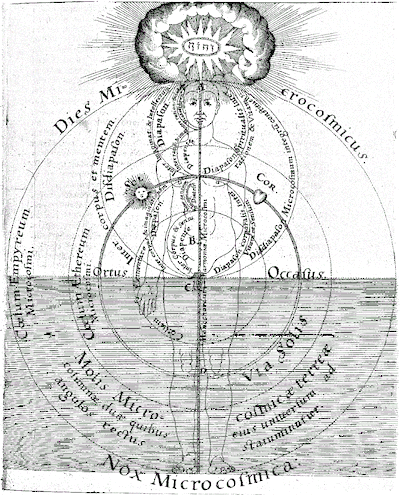
Tabula emeraldina Hermetis Trismegisti.
The emerald table (1) of Hermes Trismegistus.
Verum, sine mendacio, certum et verissimum:
(The following is) true, without falsehood, certain and very true:
Quod est inferius est sicut quod est superius
"What is lower is like what is higher
et quod est superius est sicut quod est inferius
and what is higher is like what is lower";
ad perpetranda miracula rei unius.
(Remember this) when performing the miracles of the one cause (2).
Et sicut res omnes fuerunt ab uno, meditatione unius,
And as all things are created from the one, by reflection (3) on the one,
sic omnes res natae ab hac una re adaptatione.
Thus (are) all things born of this one substance by means of adaptation (4).
Pater eius est Sol, mater eius est Luna.
Its father is Sun (5), its mother is Moon (5).
Portavit illud ventus in ventre suo.
The wind (6) carried it in its belly.
Nutrix eius terra est, pater omnis telesmi totius mundi est hic.
The nourisher of the earth she is (7), father of all perfection the world he is/is here (8).
Virtus eius integra est.
Its power is complete.
Si versa fuerit in terram, separabis terram ab igne, subtile ab spisso suaviter.
If this power is poured into the earth, carefully separate (9) earth from fire, the fine from the coarse.
Magno cum ingenio ascendit a terra in coelum
(If you act) with great understanding, (this power) rises from the earth to heaven,
Iterumque descendit in terram et recipit vim superiorum et inferiorum.
descends again to earth and receives energy from the higher and the lower.
Sic habebis gloriam totius mundi.
Thus you will gain the glory of the whole world.
Ideo fugiet a te omnis obscuritas.
Therefore (10) all darkness will flee from you.
Haec est totius fortitudinis fortitudo fortis,
This is strength in its most concentrated form (11),
quia vincet omnem rem subtilem omnemque solidam penetrabit.
Because (this force) will penetrate every tenuous and solid substance (12).
Sic mundus creatus est.
This is how the world was created.
Hinc erunt adaptationes mirabiles, quarum modus est hic.
In the manner described here (13), miraculous adaptations will result.
Itaque vocatus sum Hermes Trismegistus, habens tres partes philosophiae totius mundi.
Therefore I am called Hermes Trismegistus, because I possess the three parts of philosophy of the whole world.
Completum est quod dixi de operatione solis.
This is what I had to say about the operation of Sun (14).
-
Thierry Stravers is co-owner of Masonic Store.
He likes to combine his passion for style and elegance with his Masonic activities.
Thierry is the owner of Trenicaa marketing agency and is a board member of Loge Enlightenment No.313 O: Hoofddorp.

